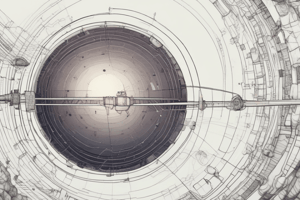Podcast
Questions and Answers
What concept is emphasized regarding vehicle collisions?
What concept is emphasized regarding vehicle collisions?
- Whiplash and mechanical deformations (correct)
- Energy dissipation only
- Momentum conservation
- Friction and resistance
Which type of deformations occur in vehicle collisions?
Which type of deformations occur in vehicle collisions?
- Elastic only
- Sliding and rolling (correct)
- Only mechanical
- None of the above
What does whiplash primarily refer to in the context of vehicle collisions?
What does whiplash primarily refer to in the context of vehicle collisions?
- The speed of the vehicles involved
- A type of energy transfer
- A sudden jerking motion of the neck (correct)
- The force exerted during a collision
In vehicle collisions, what is a characteristic of sliding deformations?
In vehicle collisions, what is a characteristic of sliding deformations?
What is the importance of understanding mechanical deformations in physics?
What is the importance of understanding mechanical deformations in physics?
Which of the following is NOT a form of deformation in vehicle collisions?
Which of the following is NOT a form of deformation in vehicle collisions?
Is angular momentum typically conserved over all time intervals in a closed system?
Is angular momentum typically conserved over all time intervals in a closed system?
What must be analyzed during an experiment involving static equilibrium?
What must be analyzed during an experiment involving static equilibrium?
Under what condition might angular momentum not be conserved?
Under what condition might angular momentum not be conserved?
Which of the following best describes static equilibrium?
Which of the following best describes static equilibrium?
What is a common method for determining the conservation of angular momentum in experiments?
What is a common method for determining the conservation of angular momentum in experiments?
Why is it important to identify discrepancies in experimental results?
Why is it important to identify discrepancies in experimental results?
What is a key difference between random errors and systematic errors?
What is a key difference between random errors and systematic errors?
How is the least count concept useful in measurements?
How is the least count concept useful in measurements?
What do error bars represent in data visualization?
What do error bars represent in data visualization?
What is the main consideration when estimating errors from multiple measurements?
What is the main consideration when estimating errors from multiple measurements?
Which of the following best describes precision?
Which of the following best describes precision?
In estimating the uncertainty of derived quantities, which factor is most crucial?
In estimating the uncertainty of derived quantities, which factor is most crucial?
Which of the following illustrates random errors?
Which of the following illustrates random errors?
What should be prioritized when comparing accuracy versus precision?
What should be prioritized when comparing accuracy versus precision?
Which of the following is NOT a quantity that is typically analyzed using graphical methods?
Which of the following is NOT a quantity that is typically analyzed using graphical methods?
What is the purpose of estimating intercepts and slopes in experimental data with linear dependence?
What is the purpose of estimating intercepts and slopes in experimental data with linear dependence?
Which of the following is NOT a characteristic of a scalar quantity?
Which of the following is NOT a characteristic of a scalar quantity?
What is the result of adding two vectors that point in opposite directions?
What is the result of adding two vectors that point in opposite directions?
What is the purpose of using unit vectors in vector representation?
What is the purpose of using unit vectors in vector representation?
Which of the following methods can be used to estimate the uncertainty in the slope of a linear fit?
Which of the following methods can be used to estimate the uncertainty in the slope of a linear fit?
What is the relationship between impulse and momentum?
What is the relationship between impulse and momentum?
Which of the following is NOT a common type of collision in physics?
Which of the following is NOT a common type of collision in physics?
What is the relationship between the period and the frequency of a periodic motion?
What is the relationship between the period and the frequency of a periodic motion?
Which of the following is NOT a type of damped oscillation?
Which of the following is NOT a type of damped oscillation?
In an underdamped oscillation, the amplitude of the oscillations:
In an underdamped oscillation, the amplitude of the oscillations:
What is resonance in the context of oscillations?
What is resonance in the context of oscillations?
Which of the following is NOT a factor that influences the period of a simple pendulum?
Which of the following is NOT a factor that influences the period of a simple pendulum?
A physical pendulum is different from a simple pendulum because:
A physical pendulum is different from a simple pendulum because:
Flashcards are hidden until you start studying
Study Notes
Uncertainties and Errors
- Differentiate random errors from systematic errors
- Identify sources and types of errors in measurement
- Use the least count concept to estimate errors associated with single measurements
- Distinguish between accuracy and precision
- Uncertainty of derived quantities and its estimation using variance
- Error bars and graphical analysis: linear fitting and transformation of functional dependence to linear form
- Estimate intercepts and slopes—and their uncertainties—in experimental data with linear dependence
Vectors
- Differentiate vector and scalar quantities
- Perform addition of vectors
- Rewrite a vector in component form
- Identify unit vectors
Physics Applications
- Recognize conservation of angular momentum over time intervals
- Perform an experiment involving static equilibrium and analyze the data
- Calculate the period and frequency of spring mass, simple pendulum, and physical pendulum
- Differentiate underdamped, overdamped, and critically damped motion
- Describe conditions for resonance in periodic motion experiments
Studying That Suits You
Use AI to generate personalized quizzes and flashcards to suit your learning preferences.




